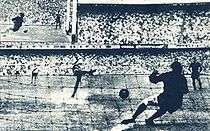Alberto Armando
| Alberto Armando | |
|---|---|
| Born |
February 4, 1910 Santa Fe, Argentina |
| Died |
December 28, 1988 (aged 78) Buenos Aires |
| Nationality | Argentine |
| Known for | President of Boca Juniors |
Alberto José Armando (February 4, 1910 – December 28, 1988) was a notable Argentine football official. He was the president of Boca Juniors from 1954 to 1955, and from 1960 to 1980.[1]
Life and career
Armando was born in Santa Fe, Argentina, in 1910, and raised in nearby San Francisco, Córdoba. He married María Mercedes Crespo and became affiliated with the Boca Juniors football club in the 1940s, when he became known as el puma. Armando was elected president of Boca Juniors in early 1954, succeeding Daniel Gil. The team had struggled since its last First Division title, in 1944, though Gil's tenure could boast the enlargement and modernization of the La Bombonera stadium.[2]
Armando's brief first turn as president during 1954-55 was marked by the team's first title in a decade. His occupation as the proprietor of an automobile dealership Ford Motor Company prompted him to resign, however.[3] He diversified his business interests in 1960, when he entered into a partnership with developer Francisco Macri to establish Tutora Insurance.[4]

Later in 1960, Armando was returned to the post of president of Boca Juniors. He undertook an ambitious program of acquiring new players, and a number would figure prominently in Boca's lineups of the 1960s and 1970s. Some of these included Antonio Roma, Silvio Marzolini, Ernesto Grillo, Dante Lugo, and Antonio Garabal (the latter three were Argentine expatriates brought back from European teams).[3] The team's First Division win over perennial rival River Plate in 1962 was the first major title since 1954, and was followed by those in 1964 and 1965, and by national championships in 1969, 1970, and 1976.[1]
His administration also invested heavily in improving facilities. La Bombonera was modernized, and bucket seats were added. A 5-hectare (13 acre) property in suburban San Justo, Buenos Aires, was purchased in 1963 for use as La Candela, the team's training grounds.[5] An aging football field was leased in Mar del Plata in 1969 for additional use during the summer months, when weather in the Buenos Aires area is least propitious for training.[3]
Armando's ambitious works program also included plans for a new stadium, for which the Argentine Congress passed a bill in 1965 donating a 40 hectares (99 acres) waterfront lot south of the Costanera Sur (the abandoned former municipal beach along the Río de la Plata in what today is the tony Puerto Madero ward). He lobbied successfully for the concession by presenting plans for a new, 140,000 seat stadium, as well as other improvements, notably a sports complex. Construction began on the mammoth Ciudad Deportiva project, and a recreational area consisting of a network of round islands connected by bridges was completed. Ultimately, however, the stadium was never built, and much of the land earmarked for the sports complex was leased to private installations, notably a restaurant and a drive-in cinema.[6]
These setbacks were accompanied by a dearth in new titles for the team lasting from 1971 to 1975. The hiring of Juan Carlos Lorenzo as head coach, however, helped revert the rut, and a national title in 1976 was followed by the team's first international title, the 1977 Copa Intercontinental. This was followed by Copa Libertadores de América titles in 1977 and 1978.[1]
The Ciudad Deportiva project continued to burden the team's finances, and in 1979, Mayor Osvaldo Cacciatore declared Boca Juniors to be in non-compliance with the 1965 deed. Following negotiations, the mayor relieved the team from nearly all further construction obligations, and in 1980 Armando retired.[6]
His successor, Martín Noel, stopped all new construction on the project, and the rapid deterioration in the team's finances after 1981 ultimately led Antonio Alegre, the team president elected in 1985, to sell the land as a means of rescuing Boca Juniors from bankruptcy. Armando, who objected to the sale, challenged Alegre in a December 1986 team election, losing narrowly; he died on December 28, 1988.[3]
Mauricio Macri, who was elected president of the club in 1995, and whose father was Armando's erstwhile business partner (Francisco Macri), renamed La Bombonera (then officially known as the Camilo Cichero Stadium) in honor of the controversial former team president: Alberto J. Armando.[7]
References
- 1 2 3 Informe Xeneize: Historia (Spanish)
- ↑ Boca Juniors: Historia (Spanish)
- 1 2 3 4 Alberto J. Armando vio "el negocio" en 1968 (Spanish)
- ↑ Ale, Ana. La Dinastía. Editorial Planeta, 2001.
- ↑ La Nación: Adiós a La Candela (Spanish)
- 1 2 Historia de la Ciudad Deportiva (Spanish)
- ↑ La Bombonera (Spanish)
External links
| Wikimedia Commons has media related to Alberto J. Armando. |